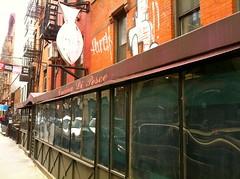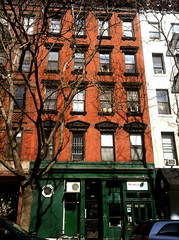Before there were squats, there were social clubs. And before pricey restaurants began taking over East Village storefronts, many were gathering places for the mob.
Every Friday and Saturday night Gideon Levy, the founder of NYC Gangster Tours, gives a tour of these onetime crime scenes, clandestine casinos and fronts for drug smuggling operations.
Born and raised in Brooklyn, Mr. Levy’s obsession with mob history started in 2003 when the film “Gangs of New York” inspired him to organize his tours, one of which winds through the East Village.
“Walking through neighborhoods that are familiar, that you might walk by every single day, you might not know about a thread that leads back to smuggling or a murder,” said Mr. Levy during a recent tour.
Many of the neighborhood’s most familiar destinations have cameos in the East Village’s mob history. For example, Umberto “Rocco” Valenti of the Morello crime family was murdered outside of John’s of 12th Street in August of 1922. The killing was in retaliation for an attempted hit on Joe “The Boss” Masseria days earlier in front of his headquarters, just down the street at 82 Second Avenue. Not two months later, the war between bootleggers continued as a man who worked at a perfume shop doubling as an illegal distillery was gunned down a block away on East 11th Street.
(A block away from John’s, at 413-415 East 12th Street, was the Shoreview Social Club, Joseph Bonnano’s longtime headquarters. According to the “Manhattan Mafia Guide,” a fire hydrant outside of the storefront “served no other purpose than to ensure parking for VIPs.”)
Another stop on the tour is the former home of a young Charles “Lucky” Luciano. The 14-year-old Luciano was kicked out of his home at 265 East 10th Street in 1914 for selling drugs. His nickname was “Sal from 14th Street,” a nod to the corner of 14th Street and First Avenue where he would hustle drugs.
Mr. Levy continued winding through the neighborhood, and stopped at De Robertis Café at 176 First Avenue. It opened in 1904 and according to him was a bookmaking operation run by the Gambino family. In 1991, eight reputed members of the family were indicted on murder and other charges after the pastry shop was wiretapped.
Just around the corner, the building that houses Buffalo Exchange Vintage Shop at 332 East 11th Street was once home to a mob-run social club, according to Mr. Levy.
In the 1920s and 1930s, he said, 87 East Fourth Street was a casino run by Luciano, which then became the Stage Bar social club run by Vincent Ciraulo, A.K.A.”Jimmy Second Avenue.” It’s now home to Cucina di Pesce.
On the same block, at 57 East Fourth Street, was the Squeeze Inn, which according to the “Manhattan Mafia Guide,” was “one of the several key points for the international heroin-trafficking ring that sent [Ralph] Polizzano, Carmine Galante and several others to prison in 1961.” The first point on that ring was Vivere Lounge at 199 Second Avenue, between East 12th and 13th Streets. “On this route,” the guide’s author Eric Ferrara writes, “couriers would allegedly deliver street-ready heroin in small travel bags or suitcases on an almost weekly basis to Di Pietro at this location, before stopping next at the Squeeze Inn on East Fourth Street and then heading to Brooklyn.”
 Vanessa Yurkevich Before it was Cucina de Pesce, 87 East Fourth Street hosted a variety of mob-run operations.
Vanessa Yurkevich Before it was Cucina de Pesce, 87 East Fourth Street hosted a variety of mob-run operations.Further downtown Mr. Levy pointed out the site of the former Ray’s Pizza on Prince Street between Elizabeth and Mott Streets. In 1998, owner Raffaele (Ralph) Cuomo was sentenced to four years in prison for making heroin sales in the pizzeria. “He admitted only to using pizzeria telephones to discuss drug sales,” read a Daily News item at the time, “but according to Frank Gioia, a turncoat Luchese mobster, Cuomo ran a lucrative heroin business out of the basement for decades.”
Despite the violent history, Mr. Levy can’t help resist the nostalgia when passing by the now-closed Ray’s and other shuttered old-school establishments on his tour. “It’s heartbreaking that the tour is turning into a used-to-be tour,” he said.





